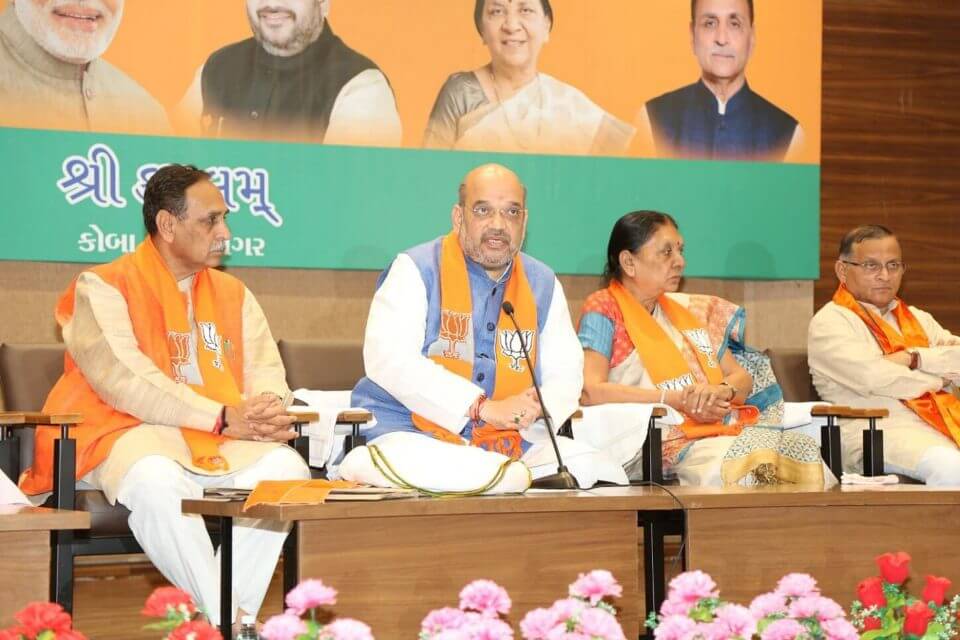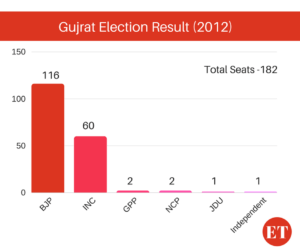The state of Gujarat is preparing for the 14th Assembly Election this November – December. Before talking about the Gujarat Elections 2017, it is essential to evaluate the BJP’s tenure in the last five years.
After winning assembly elections for the straight fifth time in 2012, BJP is considered to be the second-to-none dominant force in Gujarat. Home state of PM Narendra Modi, Gujarat, has seen many ups and downs under BJP government in the last 15 years. However, if we look at the performance of BJP overall, we can only praise the work done by Narendra Modi and BJP. However, after Modi went at the central level, Gujarat has been governed under the watch of Anandiben Patel and current CM Vijay Rupani. Let us look at how BJP has performed in Gujarat after the departure of Modi.
Employment:

Contrary to the state government’s tall claims of providing employment to over one lakh youths in two months, the figures tabled in the state assembly revealed that the state has around 6 lakh registered unemployed youths at its various employment exchanges. In the last five years since 2011-12, the government has been able to give employment to only 80,511 youths. According to the figures given by the government in the assembly, in top five districts — Ahmedabad, Vadodara, Surat, Rajkot, and Mehsana — there was 2.10 lakh unemployed youths with Ahmedabad city having the highest number of 56,012.
Read more: Why Congress Is Unable To Defeat BJP In Gujarat?
In Kutch, the government was able to give the maximum 9,585 jobs to unemployed youths in the past five years. The data revealed that between December 1, 2011, and November 30, 2012, 12,630 persons were given jobs, while during the same period in 2012-13, 21,309 youths were given employment. In the last five years, the minimum 6,630 jobs were given between December 1, 2015, and November 30, 2016. While the highest 25,036 persons were given employment between December 1, 2013, and November 30, 2014. Of the 80,511 youths who got jobs in the past five years, 52,914 were from the rural areas.
Interestingly in the last two years, the state government has employed just one person in the government sector.
This shows that government has been completely successful in its promises in context to the unemployment problems.
Agricultural Growth:

Gujarat has suffered two back-to-back droughts, and the farmers there have been agitating for the past year and a half for a higher minimum support price for cotton. Gujarat is the country’s largest producer of cotton. World cotton prices fell by over 40% in 2014 and this was accompanied by drought in Saurashtra and other cotton producing areas. Incidentally, these regions are also Patel strongholds and the Patidar farming community, traditionally strong BJP supporters, is said to have boycotted voting in many areas. In Gujarat, farmers had been agitating for a higher minimum support price but what they got was a much-reduced support price from the Centre. Until 2011-12, cotton farmers received Rs. 7,000 per quintal as the minimum support price but this got progressively reduced to Rs. 4050 per quintal by mid-2015. The farmers claim that at Rs. 4050 per quintal, they barely cover their costs. The droughts in 2014 and 2015 worsened their plight.
In May 2014, the BJP manifesto promised that farmers would earn a 50% profit over their total input costs. But the Gujarat cotton farmers are barely covering their costs and the Centre has forgotten all about the party’s manifesto promises. The manifesto also said it would create a price fluctuation fund to insulate farmers from volatile global prices. Cotton prices fell over 40% during 2014 and early 2015. The government created a token price fluctuation fund of Rs. 400 crore which was hardly sufficient.
Read more: Rahul Gandhi Vows To Make A Comeback In Gujarat Elections
This proves that BJP has not at all been successful in keeping the farmers happy. The farmers have not supported BJP in the past election when most of the rural seats went against BJP and it seems this time it will be no different.
Poverty issues:
Poverty has been one of the major issues for the BJP in Gujarat. When BJP won the elections in 2012, more than 30 Lakh people were suffering from poverty. This number has risen to almost 40% since last decade. According to reports in 2013, almost 40% of the population of Gujarat suffered from poverty. Gujarat was ranked 13th among 17 states in the highest rate of poverty population. And this rate has been increasing in the last few years. ON April 29, 2016, the Gujarat government announced a 10 percent quota for the economically weaker section — with an annual income of Rs 6 lakh or less — in a bid to satisfy the middle class that has traditionally been against caste-based reservation. Political observers, however, feel the move is a gamble that may not withstand a legal challenge. This helped the Patidar agitation started, the feeling arose that children from poor families of such castes, who have not got a reservation, are finding it difficult to get admissions in educational institutions and government jobs. Also, yojnas such as Mukhyamantari Yuva Swalamban Yojna have helped the state of the poor in the state.
Tourism Development:
The ‘Khushboo Gujarat Ki’ campaign is well past its prime. Amitabh Bachchan’s appearance in the campaign, which first went on air in 2010, had given a shot in the arm to Gujarat’s tourism sector then. But, the state still manages to hold on to impressive growth rates in tourist footfalls. On a much-enlarged base, it has accomplished a 16.94 percent growth in tourist arrivals in FY17 over the previous year.
Gujarat’s tourist inflow grew from 38.3 million in FY16 to 44.8 million in FY17. Tourist inflow from other Indian states grew 22 percent. Business remained the dominant purpose of visit, at 55 percent of tourist inflow, followed by spiritual tourists at 36 percent. According to data collected from the Gujarat Industrial and Technical Consultancy Organization (Gitco), which manages the Tourist Flow Information System for the Tourism Corporation of Gujarat Ltd, the growth in tourist inflow was 263 percent compared to 2006-07.
The compounded annual growth rate (CAGR) of tourist inflow during a five-year period between FY07 and FY12 was 12.62 percent, while the CAGR of tourist inflow during the past five-year period between| FY12 and FY17is 14.91 percent, marking an improvement.
RM Patel, chief consultant, Gitco, highlighted tourist inflow from other Indian states rose from 9.39 million in FY16 to 11.4 million in FY17. During the year, 519,000 non-resident Indians (NRIs) and 405,000 foreigners visited Gujarat as well. Leisure tourist inflow increased from 2.5 million in FY16 to 3.1 million in FY17. Spiritual tourists’ footfalls have grown 24.6 percent while business tourist arrivals have grown 14.7 percent.
GDP growth of Gujarat:
Gujarat model seems to be slowing down on the growth path. In the first year under Anandiben Patel as chief minister in 2014-15, the state has recorded lowest ever growth rate in GSDP (Gross State Domestic Product) at 7.7%. This is not it, according to the data recently released by the ministry of planning; Gujarat moved out from the list of top 5 states in terms of GSDP growth and is ranked lowly at 10th position in 2014-15 in comparison to other states. In 2012-13, Gujarat was at second rank with a growth rate of 10.8% when PM Narendra Modi was at the helm as chief minister. The GSDP data is based on the prices of 2011-12.
The industry experts claim that Gujarat being highly industrialized state depends majorly on industrial output but due to slowdown, the industrial output dipped heavily leading to slower growth.
According to estimates as per constant prices, the GSDP growth of Gujarat in 2015-16 stood at mere 6.7%, lowest in last 10 years. This was 7.7% in 2014-15; 8.3% in 2013-14; and 10.8% in 2012-13, according to the data of ministry of planning. The size of the state GSDP in 2015-16 (according to advance estimates) is expected to be Rs 9, 84,971 crores.
In 2014-15, Gujarat is lagging behind states like Bihar, Jharkhand, Maharashtra, Tamil Nadu, Telangana, Andhra Pradesh, Chhattisgarh, Karnataka and even Delhi.
What do people of Gujarat think of the BJP performance?
According to the opinion polls conducted by abplive on 31st August 2017, it is believed that most of the people of Gujarat are satisfied with the performance of BJP in the past five years. According to the opinion poll, the upcoming election of Gujarat appears like a ‘no-contest’ with the BJP leading its arch-rival by over thirty percentage points in terms of people’s voting intention.
59 percent respondents said that they would vote for the BJP if state elections were to take place now. Only 29% were found to be rooting for the Congress. This means that the BJP has thus far managed to retain the level of support it received in the 2014 Lok Sabha election and the Congress has slid down further.
We can safely infer that even after Modi left Gujarat, BJP has done satisfactory work in the state. Projects like BRTS, Riverfront project, and Metro Rail projects have been proven successful in the state. Some sectors have benefitted and some have not developed well. But overall, Gujarat has seen development in the Modi-less government. Although BJP might have lost its popularity after Modi left, it still seems BJP is set for one more tenure in the state.


